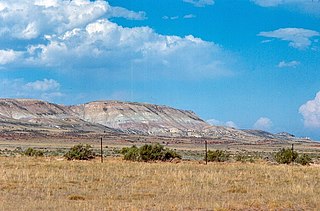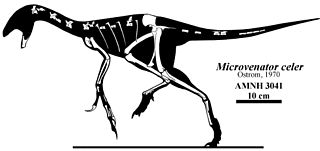
Rhynchocephalia is an order of lizard-like reptiles that includes only one living species, the tuatara of New Zealand. Despite its current lack of diversity, during the Mesozoic rhynchocephalians were a speciose group with high morphological and ecological diversity. The oldest record of the group is dated to the Middle Triassic around 238 to 240 million years ago, and they had achieved a worldwide distribution by the Early Jurassic. Most rhynchocephalians belong to the group Sphenodontia ('wedge-teeth'). Their closest living relatives are lizards and snakes in the order Squamata, with the two orders being grouped together in the superorder Lepidosauria.

Como Bluff is a long ridge extending east–west, located between the towns of Rock River and Medicine Bow, Wyoming. The ridge is an anticline, formed as a result of compressional geological folding. Three geological formations, the Sundance, the Morrison, and the Cloverly Formations, containing fossil remains from the Late Jurassic of the Mesozoic Era are exposed.
Coelurus is a genus of coelurosaurian dinosaur from the Late Jurassic period. The name means "hollow tail", referring to its hollow tail vertebrae. Although its name is linked to one of the main divisions of theropods (Coelurosauria), it has historically been poorly understood, and sometimes confused with its better-known contemporary Ornitholestes. Like many dinosaurs studied in the early years of paleontology, it has had a confusing taxonomic history, with several species being named and later transferred to other genera or abandoned. Only one species is currently recognized as valid: the type species, C. fragilis, described by Othniel Charles Marsh in 1879. It is known from one partial skeleton found in the Morrison Formation of Wyoming, United States. It was a small bipedal carnivore with elongate legs.

Microvenator is a genus of dinosaur from the Early Cretaceous Cloverly Formation in what is now south central Montana. Microvenator was an oviraptorosaurian theropod. The holotype fossil is an incomplete skeleton, most likely a juvenile with a length of 1.3 m (4.3 ft), and consequently, the adult size remains uncertain. Microvenator celer is primitive and may be the "sister taxon to all other oviraptorosaurs."

Tanycolagreus is a genus of coelurosaurian theropod from the Late Jurassic of North America.

Homoeosaurus is an extinct genus of rhynchocephalian reptile, known from the Late Jurassic-earliest Cretaceous of Europe, with specimens being reported from France, England and Germany. Several species have been described within the genus, based on varying proportions of the limb bones to the body length based on the presacral vertebrae. Specimen C.M.6438 of H. maximiliani from Germany has a total length of around 17 centimetres (6.7 in), with a skull length of about 1.7 centimetres (0.67 in). In comparison to other rhynchocephalians, the limbs are proportionally long. Recent studies have classified Homoeosaurus as a member of Neosphenodontia, with some studies including it as part of the clade Leptorhynchia, also including sapheosaurs, pleurosaurs, Kallimodon and Vadasaurus. Despite being found in aquatic deposits, it is suggested to have been terrestrial. It is thought to have been a carnivore/insectivore. One specimen was found as stomach contents of the fish Belonostomus.
Utahdactylus was a genus of extinct reptile from the Kimmeridgian-Tithonian-age Upper Jurassic Morrison Formation of Utah, United States. Based on DM 002/CEUM 32588, Czerkas and Mickelson (2002) identified it as a "rhamphorhynchoid" pterosaur. Bennett (2007) later concluded that it has no diagnostic features of the Pterosauria, and cannot be positively identified beyond being an indeterminate diapsid. More recent work on newly prepared material, however, seems to confirm once again that Utahdactylus was a pterosaur.

Clevosaurus is an extinct genus of rhynchocephalian reptile from the Late Triassic and the Early Jurassic periods. Species of Clevosaurus were widespread across Pangaea, and have been found on all continents except Australia and Antarctica. Five species of Clevosaurus have been found in ancient fissure fill deposits in south-west England and Wales, alongside other sphenodontians, early mammals and dinosaurs. In regards to its Pangaean distribution, C. hadroprodon is the oldest record of a sphenodontian from Gondwana, though its affinity to Clevosaurus has been questioned.

Cynosphenodon is an extinct genus of rhynchocephalian in the family Sphenodontidae from the Middle Jurassic La Boca Formation of Tamaulipas, Mexico. It is known from a largely complete lower jaw and fragments of the upper jaw. It is suggested to be among the closest known relatives of the tuatara, with both being placed in the Sphenodontinae, which is supported by among other characters, the growth pattern of the teeth.
Eromangasaurus is an extinct genus of elasmosaurid known from northern Queensland of Australia.
Comodon is an extinct genus of Late Jurassic mammal from the Morrison Formation of Wyoming. Fossils of this taxon are present in stratigraphic zone 5.

Opisthias is a genus of sphenodont reptile. The type species, Opisthias rarus, is known from the Late Jurassic (Kimmeridgian-Tithonian) of western North America.

Platyognathus is an extinct genus of protosuchian crocodyliform. Fossils are known from the Early Jurassic Lower Lufeng Formation in Yunnan, China and belong to the type and only species, P. hsui.
Godavarisaurus is an extinct genus of sphenodontian reptile from the Early-Middle Jurassic Kota Formation of Andhra Pradesh, India. It is known from jaw fragments. It was a small sphenodontian, with the skull estimated to be less than 2 centimetres (0.79 in) long. It is generally considered to be a relatively basal sphenodontian that lies outside Eusphenodontia.
Zapatadon is an extinct genus of sphenodontid reptile from the end of the Early Jurassic in the lower part of La Boca Formation of Tamaulipas, Mexico. Is known from a nearly complete skull with mandible of a post-hatchling individual, and is one of the smallest skulls between the sphenodontians, with an estimated total length of 11.3 millimetres, a bit smaller than the hatchling individuals observed in the modern tuatara (Sphenodon); features like the oblique mandibular symphysis suggests that the holotype is from an individual in a relatively mature stage of ontogenic development. Zapatadon is diagnosed by their hatchling tooth series located in a depression in the anterior part of the dentary bone, the prefrontal bone surrounding the dorsal process of the maxilla and the broad jugal that extends over the maxillary suborbital process, been almost excluded of the orbit.

Pamizinisaurus is a genus of sphenodontian reptile known from Lower Cretaceous (Albian) Tlayúa Formation of central Mexico. It was named Pamizinsaurus tlayuaensis by Reynoso in 1997, after Tlayua Quarry were it was found. It is known from the crushed skeleton of a juvenile individual, with a skull length of around 16 millimetres (0.63 in), and a total length of about 77 millimetres (3.0 in). The fossil was covered in small round osteoscutes, unique among known sphenodontians but similar to those of helodermatid lizards like the Gila monster, which probably served to protect it from predators.
Eobatrachus is a dubious genus of extinct frog known only from the holotype, YPM 1862, part of the right humerus, found in Reed's Quarry 9 near Como Bluff, Wyoming in the Late Jurassic-aged Morrison Formation. The type, and only species, E. agilis, was named by Othniel Charles Marsh in 1887 and he initially interpreted it as a mammal, although it was later re-classified as a genus of frog related to Comobatrachus and Eobatrachus is now seen as a dubious amphibian genus, possibly belonging to Anura (frogs) according to Foster (2007).

Lusonectes is an extinct genus of microcleidid plesiosaur from the Early Jurassic (Toarcian) São Gião Formation of Portugal.
Bharatagama is an extinct genus of lepidosaur from the Early Jurassic of India. It has been suggested to be one of the oldest known lizards and the oldest known iguanian. The type and only species is Bharatagama rebbanensis, named in 2002. Over one hundred fossils of Bharatagama have been found in the Kota Formation, which outcrops in the Pranhita–Godavari Basin and dates back to about 190 million years ago (Ma). Despite its abundance, Bharatagama is known only from isolated jaw bones mixed together in microvertebrate assemblages with equally fragmentary remains of fish, sphenodontians, dinosaurs, crocodylomorphs, and mammals. These fossils represent all stages of development, from hatchlings to adults. The total length of the skull in adult specimens is estimated to have been about 15 millimetres (0.59 in). Later analysis suggested that the taxon might be a member of Rhynchocephalia.

Sphenovipera jimmysjoyi is an extinct species of sphenodontian dated from the Middle Jurassic. If was discovered in the lower part of the La Boca Formation located in Tamaulipas, Mexico. Only the lower jaw of this organism has been discovered and studied. It is possibly the only species of rhynchocephalian yet discovered to show evidence of venom delivery.












